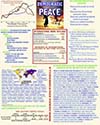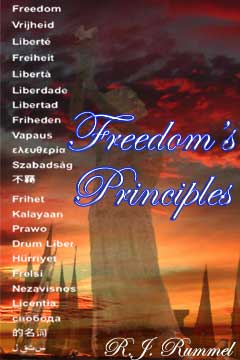[First published May 9, 2006] I think I solved the puzzle of why my posted images always showed on the Mac and only sometimes on PCs, thus requiring me to provide alternative links. It has to do with leaving empty the height and width containers for an image, e.g., putting nothing after the equality for height= and width=. If the dimensions of an image are okay as is, these containers should be omitted. I haven’t been doing that, but will do so now.
Before providing a final list of mortacracies, there is one more term to add to those I’ve been using. As you know, I use “democide” for murder by government, and I’ve used “mortality” for the unintentional deaths resulting from the negative, life endangering effects of government policies or actions, such as corrosive top to bottom corruption, the nationalization of farmlands, the encouragement of communal violence, and the deterioration of health and education services.
The verb would be “mortalize” as in Mugabe of Zimbabwe is mortalizing his subjects by his devastating economic policies.
But, as I worked the data on mortality, I have felt these terms to be incomplete. I needed something comparable to democide, and “mortalize” does not seem right. At first I rejected “mortacide” as doubling “to kill,” but then I rechecking the definitions of “mort” in the world’s greatest authority on English, the Oxford English Dictionary. The most relevant definitions are:
1. The condition of being subject to death.
2. The loss of life on a large scale.
3. Abnormal frequency of death.
Now, adding the Latin suffix “-cide” (killer, or act of killing) to “mort” to get “mortacide,” makes the causes of death active, as though the result of policies and actions that were so life threatening that they caused large scale deaths, although unintentionally so.
Thus, I will use three terms:
Democide: murder by government.
Mortacide: death by government.
Mortacracy: A government that is committing sizable democide and mortacide.
Also, one more thing. I’ve mentioned here and in some of the previous blogs the devastating effect of corruption on the welfare of a people. Corruption plays a large role in defining mortacide, but I suspect that not many readers living in democracies have a sense for what true corruption of this kind is like. In comparison to the corruption in many thug regimes, that in democracies is as a candle to a forest fire. Perhaps the following on such corruption in Angola will help (from Martin Meredith, The Fate Of Africa: From the Hopes of Freedom to the Heart of Despair, p. 616):
“[T]he Economist Intelligence Unit in 2003…reported that there were thirty-nine individuals in Angola worth at least $50 million and another twenty reportedly worth at least $100 million. Six of the seven wealthiest people on its list were longtime government officials, and the seventh was a recently retired official. Overall, the combined wealth of these fifty-nine people was at least $3.95 billion. By comparison, the total gross domestic product of Angola, with a population of about 14 million, was about $10.2 billion in 2002.
“The stark contrast between the rich elite and the mass poverty of the rest of the population was nowhere more evident than in [the capital of] Luanda. Its streets were packed with the latest models of Mercedes-Benz and Toyota Land Cruisers; jet skis circled the bay; prices in air-conditioned shopping malls were equivalent to those in London. But milling around on street corners were groups of street children and mutilados [Portuguese for the mutilated] begging from the passing traffic. Half of the city’s population of 4 million had no access to clean water and survived on untreated water from the Bengo River bought by the bucketful from informal vendors. Most Angolans subsisted on less than seventy cents a day.”
So, who are the mortacracies? I have defined possible candidates in the following blogs:
“Who Are The Mortacracies? Part I”: Candidate mortacracies based on democide.
“Who Are the Mortacracies? Part II”: Candidate mortacracies based on life expectancy at birth.
“Who Are the Mortacracies? Part III”: One group of candidate mortacracies based on the average of a Human Development Index and Life Expectancy Index; another group based on my intuitive judgment of who were the mortacracies.
“Who Are the Mortacracies? Part IV”: Candidate mortacracies based on the fall in life expectancy from 1998 to 2006.
“Who Are the Mortacracies? Part V”: Candidate mortacracies based on 8 indicators of failed states.
Thus, I have 5 tables of candidate mortacracies from which to pick. To make this selection systematic and as objective as possible, I will use the frequency of occurrence of a state across the 5 groups as my criteria. Surely, if a state is listed in only one table, it would not be a good choice, although it may have the potential to be a mortacracy. I present below this group:
I eliminated the free states of Grenada, Mali, Namibia, Nauru, and Trinidad and Tobago from this list, as there were reasons for their death toll beyond the capacity and policies of their governments, such as the effects of hurricanes, deep impoverishment due to previous unfree regimes, and rampant HIV. It would be misleading to characterize such states as potential mortacracies.
Then there is the group of states that appeared in 2 tables of candidates out of the five. I show the list below:
Here also I eliminated free states—Botswana, Lesotho, and South Africa—for the same reasons given above, with the exception of hurricane caused mortality.
Finally, after all this work I hope that your patience is rewarded with the final list of mortacracies that appeared in 3 or more tables of candidates. I give it below (if this does not appear or is hard to read, see:
There you have it.
This list is complete; I removed no free states. That the deadly Central African Republic appeared in all 5 tables is consistent with what we know about the country, and similarly with Chad and Sierra Leone. And we have North Korea, Burma, and Sudan on the list, as well as the bloody Congo (Kinshasa—formerly Zaire). Corrupt Angola also appears.
Although this list was arrived at systematically, it is a list that surely contains those states that would most likely be chosen by those familiar with the human cost of the world’s worst thug regimes.
So, what do we do about these mortacracies? I will try to answer this in the next blog.
Links of Note
“An Incomplete Peace: Sudan’s Never-Ending War With Itself”
“[Chad:] Fear of ‘Disappearance’ and extrajudicial execution “
“Thousands flee from [Central African Republic] violence”
GENOCIDE AGAINST THE KAREN PEOPLE IN BURMA”
“Equatorial Guinea: Further Information on Torture/Health concern/Fear for Safety”
“Mozambique: Deaths of 80 people in custody must be investigated by independent experts”
“Nigeria: Deaths rise in Lagos clashes, thousands flee”
[SIERRA LEONE]”WE’LL KILL YOU IF YOU CRY”
“Revealed: the gas chamber horror of North Korea’s gulag”
“ZIMBABWE: Death rate mounts in political violence”



 Posted by rudyrummel
Posted by rudyrummel 






